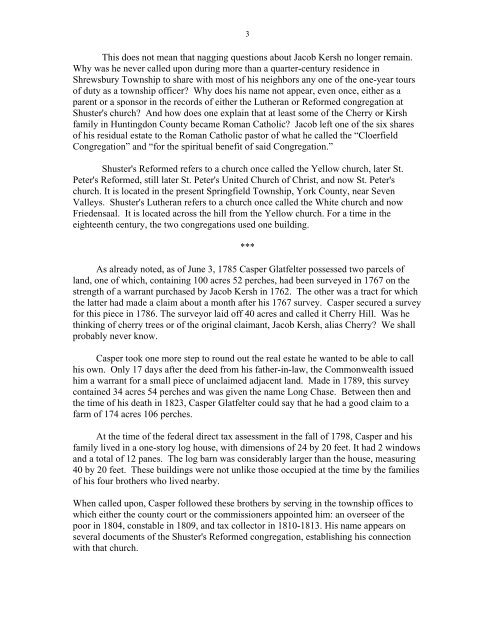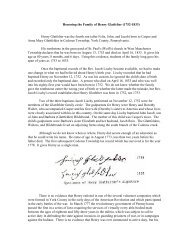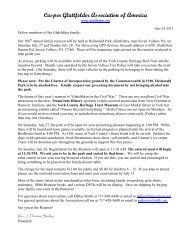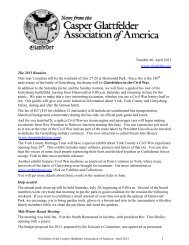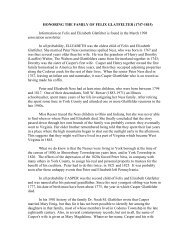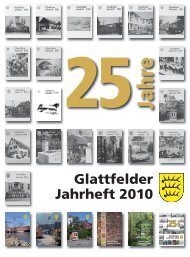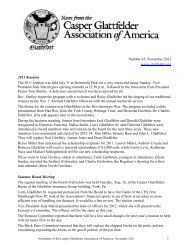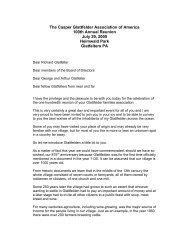HONORING THE FAMILY OF CASPER GLATFELTER (1758-1823)
HONORING THE FAMILY OF CASPER GLATFELTER (1758-1823)
HONORING THE FAMILY OF CASPER GLATFELTER (1758-1823)
You also want an ePaper? Increase the reach of your titles
YUMPU automatically turns print PDFs into web optimized ePapers that Google loves.
3<br />
This does not mean that nagging questions about Jacob Kersh no longer remain.<br />
Why was he never called upon during more than a quarter-century residence in<br />
Shrewsbury Township to share with most of his neighbors any one of the one-year tours<br />
of duty as a township officer? Why does his name not appear, even once, either as a<br />
parent or a sponsor in the records of either the Lutheran or Reformed congregation at<br />
Shuster's church? And how does one explain that at least some of the Cherry or Kirsh<br />
family in Huntingdon County became Roman Catholic? Jacob left one of the six shares<br />
of his residual estate to the Roman Catholic pastor of what he called the “Cloerfield<br />
Congregation” and “for the spiritual benefit of said Congregation.”<br />
Shuster's Reformed refers to a church once called the Yellow church, later St.<br />
Peter's Reformed, still later St. Peter's United Church of Christ, and now St. Peter's<br />
church. It is located in the present Springfield Township, York County, near Seven<br />
Valleys. Shuster's Lutheran refers to a church once called the White church and now<br />
Friedensaal. It is located across the hill from the Yellow church. For a time in the<br />
eighteenth century, the two congregations used one building.<br />
***<br />
As already noted, as of June 3, 1785 Casper Glatfelter possessed two parcels of<br />
land, one of which, containing 100 acres 52 perches, had been surveyed in 1767 on the<br />
strength of a warrant purchased by Jacob Kersh in 1762. The other was a tract for which<br />
the latter had made a claim about a month after his 1767 survey. Casper secured a survey<br />
for this piece in 1786. The surveyor laid off 40 acres and called it Cherry Hill. Was he<br />
thinking of cherry trees or of the original claimant, Jacob Kersh, alias Cherry? We shall<br />
probably never know.<br />
Casper took one more step to round out the real estate he wanted to be able to call<br />
his own. Only 17 days after the deed from his father-in-law, the Commonwealth issued<br />
him a warrant for a small piece of unclaimed adjacent land. Made in 1789, this survey<br />
contained 34 acres 54 perches and was given the name Long Chase. Between then and<br />
the time of his death in <strong>1823</strong>, Casper Glatfelter could say that he had a good claim to a<br />
farm of 174 acres 106 perches.<br />
At the time of the federal direct tax assessment in the fall of 1798, Casper and his<br />
family lived in a one-story log house, with dimensions of 24 by 20 feet. It had 2 windows<br />
and a total of 12 panes. The log barn was considerably larger than the house, measuring<br />
40 by 20 feet. These buildings were not unlike those occupied at the time by the families<br />
of his four brothers who lived nearby.<br />
When called upon, Casper followed these brothers by serving in the township offices to<br />
which either the county court or the commissioners appointed him: an overseer of the<br />
poor in 1804, constable in 1809, and tax collector in 1810-1813. His name appears on<br />
several documents of the Shuster's Reformed congregation, establishing his connection<br />
with that church.


